
- |<
- <
- 1
- >
- >|
-
Yoshihide Yamanashi, Tappei Takada, Hiroshi Suzuki2018Volume 41Issue 1 Pages 1-10
Published: January 01, 2018
Released on J-STAGE: January 01, 2018
JOURNAL FREE ACCESS FULL-TEXT HTMLWesternization of dietary habits leads to an increase in lipid intake and is thought to be responsible for an increase in patients with dyslipidemia. It is a well-known fact that the impaired cholesterol homeostasis is closely related to the development of various lifestyle-related diseases such as fatty liver, diabetes, and gallstone as well as dyslipidemia leading to atherosclerosis and cardiovascular diseases such as heart attack and stroke. Therefore, appropriate management of cholesterol levels in the body is considered important in prevention and treatments of these lifestyle-related diseases and in addition, molecular mechanisms controlling plasma (and/or hepatic) cholesterol levels have been intensively studied. Due to its hydrophobicity, cholesterol was long believed to pass through cell membranes by passive diffusion. However, recent studies have identified a number of plasma membrane transporters that are responsible for the cellular uptake or efflux of cholesterol and involved in developments of lifestyle-related diseases. In this review, we focus on Niemann–Pick C1 Like 1 (NPC1L1) and a heterodimer of ATP-binding cassette transporter G5 and G8 (ABCG5/G8), both of which are responsible for intestinal cholesterol absorption and biliary cholesterol secretion, and discuss the relationship between these cholesterol transporters and lifestyle-related diseases. In addition, we also discuss the related uncertainties that need to be explored in future studies.
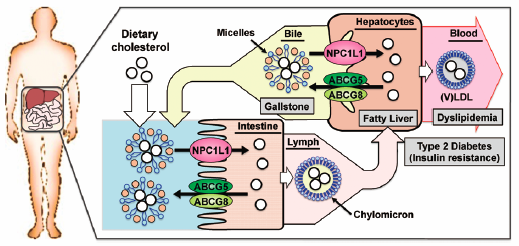 Graphical Abstract Fullsize ImageView full abstractDownload PDF (2326K) Full view HTML
Graphical Abstract Fullsize ImageView full abstractDownload PDF (2326K) Full view HTML -
Kentaro Yano, Takumi Tomono, Takuo Ogihara2018Volume 41Issue 1 Pages 11-19
Published: January 01, 2018
Released on J-STAGE: January 01, 2018
JOURNAL FREE ACCESS FULL-TEXT HTMLThis review deals with recent advances in studies on P-glycoprotein (P-gp) and its expression regulators, focusing especially on our own research. Firstly, we describe findings demonstrating that the distribution of P-gp along the small intestine is heterogeneous, which explains why orally administered P-gp substrate drugs often show bimodal changes of plasma concentration. Secondly, we discuss the post-translational regulation of P-gp localization and function by the scaffold proteins ezrin, radixin and moesin (ERM proteins), together with recent reports indicating that tissue-specific differences in regulation by ERM proteins in normal tissues might be retained in corresponding cancerous tissues. Thirdly, we review evidence that P-gp activity is enhanced in the process of epithelial-to-mesenchymal transition (EMT), which is associated with cancer progression, without any increase in expression of P-gp mRNA. Finally, we describe two examples in which P-gp critically influences the brain distribution of drugs, i.e., oseltamivir, where low levels of P-gp associated with early development allow oseltamivir to enter the brain, potentially resulting in neuropsychiatric side effects in children, and cilnidipine, where impairment of P-gp function in ischemia allows cilnidipine to enter the ischemic brain, where it exerts a neuroprotective action.
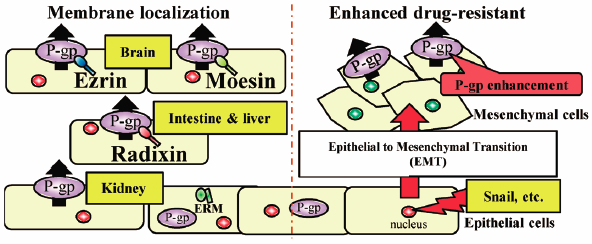 Graphical Abstract Fullsize ImageView full abstractDownload PDF (1306K) Full view HTML
Graphical Abstract Fullsize ImageView full abstractDownload PDF (1306K) Full view HTML
-
Yutaro Obara, Kuniaki Ishii2018Volume 41Issue 1 Pages 20-23
Published: January 01, 2018
Released on J-STAGE: January 01, 2018
JOURNAL FREE ACCESS FULL-TEXT HTML
Supplementary materialWe recently found that 10.5% of sporadic Parkinson’s disease (PD) patients lacked one copy of the midnolin (MIDN) gene. In addition, gene knock-down/out of MIDN caused down-regulation of parkin E3 ubiquitin ligase, indicating MIDN to be a novel PD-risk factor or causative gene. In this study, we performed RNA-sequencing and transcriptome analysis of Midn wild-type and knockout cells. Midn positively or negatively regulated the expression of a wide variety of genes, including causative familial PD genes, such as α-synuclein, parkin, and EIF4G1. However, EIF4G1 protein levels were not altered by the reduction of its mRNA by Midn loss, as seen that parkin protein levels were correlated to the mRNA down-regulation. Taken together, these findings indicate that MIDN regulates the expression of a wide variety of genes, including multiple PD-causative genes and is associated with PD onset.
 Graphical Abstract Fullsize ImageView full abstractDownload PDF (536K) Full view HTML
Graphical Abstract Fullsize ImageView full abstractDownload PDF (536K) Full view HTML
-
Kohei Togami, Anri Kitayama, Takayuki Daisho, Rui Wang, Hitoshi Tada, ...2018Volume 41Issue 1 Pages 24-28
Published: January 01, 2018
Released on J-STAGE: January 01, 2018
JOURNAL FREE ACCESS FULL-TEXT HTMLIn this study, we examined the usefulness of a tissue-clearing technique for the evaluation of the lung distribution of aerosolized drugs. An aerosol formulation of TexasRed dextran (70 kDa), a model compound of drug carrier for aerosolized drugs, was administered intrapulmonarily to mice using a MicroSprayer, and then DyLight 488-conjugated tomato lectin was administered intravenously to visualize general lung structure via the fluorescent labeling of alveolar and bronchial epithelial cells. Tissue clearing followed by laser scanning confocal microscopy enabled the three-dimensional visualization of intrapulmonary TexasRed dextran and the evaluation of its distribution at the alveolar scale without the preparation of thin tissue sections. These findings suggest that tissue-clearing techniques are useful for the evaluation of intrapulmonary distribution and development of pulmonary drug delivery systems.
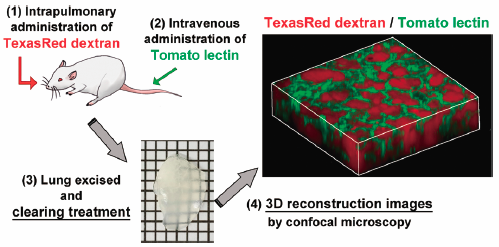 Graphical Abstract Fullsize ImageView full abstractDownload PDF (10155K) Full view HTML
Graphical Abstract Fullsize ImageView full abstractDownload PDF (10155K) Full view HTML -
Hye Jin An, Bonggi Lee, Seong Min Kim, Dae Hyun Kim, Ki Wung Chung, Su ...2018Volume 41Issue 1 Pages 29-35
Published: January 01, 2018
Released on J-STAGE: January 01, 2018
JOURNAL FREE ACCESS FULL-TEXT HTML
Supplementary materialNonalcoholic fatty liver disease (NAFLD) is frequently observed in obese and aged individuals. Peroxisome proliferator-activated receptors (PPARs) play a role in regulating hepatic lipid accumulation, a hallmark of NAFLD development. A PPAR pan agonist, 2-(4-(5,6-methylenedioxybenzo[d]thiazol-2-yl)-2-methylphenoxy)-2-methylpropanoic acid (MHY2013) has been shown to prevent fatty liver formation and insulin resistance in obese mice (db/db) model. However, the beneficial effects of MHY2013 in aged model remain unknown. In this study, we investigated whether MHY2013 alleviates hepatic lipid accumulation in aged Sprague–Dawley (SD) rats. We confirmed that MHY2013 increased the activities of three PPAR subtypes in HepG2 cells using luciferase assay. When administered orally in aged SD rats, MHY2013 markedly decreased the hepatic triglyceride levels without changes in body weight. Regarding underlying mechanisms, MHY2013 increased the mRNA levels of lipid oxidation-related genes, including carnitine palmitoyltransferase 1 (CPT1) and peroxisomal acyl-CoA oxidase 1 (ACOX1), without apparent change in the mRNA expression of lipogenesis-related genes. Furthermore, MHY2013 significantly increased systemic fibroblast growth factor 21 (FGF21) and adiponectin levels and suppressed inflammatory mRNA expression in the liver. In conclusion, MHY2013 alleviated age-related hepatic lipid accumulation, in part by upregulating β-oxidation signaling and suppressing inflammation in the liver. Therefore, MHY2013 is a potential pharmaceutical agent for treating age-related hepatic lipid accumulation.
 Graphical Abstract Fullsize ImageView full abstractDownload PDF (1303K) Full view HTML
Graphical Abstract Fullsize ImageView full abstractDownload PDF (1303K) Full view HTML -
Yuanzhang Zhu, Yingyi Pan, Guibiao Zhang, Yingchun Wu, Weicai Zhong, C ...2018Volume 41Issue 1 Pages 36-46
Published: January 01, 2018
Released on J-STAGE: January 01, 2018
Advance online publication: October 31, 2017JOURNAL FREE ACCESS FULL-TEXT HTMLChelerythrine (CHE) is a type of benzophenanthridine alkaloid found in many herbs and is also the main alkaloid constituent of Toddalia asiatica (L.) LAM. It has been proven to have various activities including antitumor, antifungal, anti-inflammatory and anti-parasitic effects. We have previously demonstrated that CHE can inhibit proliferation and promote apoptosis in human hepatocellular carcinoma (HCC) cells. However, the effect of CHE on the metastasis of HCC and its related molecular mechanisms have yet to be validated. In this study, we investigated the effects of CHE on the migration and invasion of the HCC cell line Hep3B. 3-(4,5-Dimethylthiazol-2-yl)-2,5-diphenyltetrazolium bromide (MTT), wounding healing, transwell migration and invasion assays and cytoskeleton staining demonstrated that CHE could inhibit the migration and invasion of Hep3B cells in a dose-dependent manner with change of cell structure. RNA interference studies made a knockdown of matrix metalloproteinase (MMP)-2/9 respectively in Hep3B cells. And the results of wounding healing and transwell invasion assay with the treatment of small interfering RNA (siRNA) investigated that MMP-2/9 are positively associated with Hep3B cell metastasis. The results of enzyme-linked immunosorbent assay (ELISA), Western blotting and quantitative RT-PCR showed that CHE suppressed the expression of MMP-2/9 at both mRNA and protein levels. CHE also exhibited an inhibitory effect on the phosphorylation of Focal adhesion kinase (FAK), phosphatidylinositol 3-kinase (PI3K), Akt, mammalian target of rapamycin (mTOR), c-Jun N-terminal kinase (JNK), extracellular signal-regulated kinases (ERK) and p38. In summary, on Hep3B cells, CHE could change the cell cytoskeletal structures through reducing the expression of p-FAK and inhibit the metastasis of Hep3B cells by downregulating the expression of MMP-2/9 mainly through PI3K/Akt/mTOR signaling pathway.
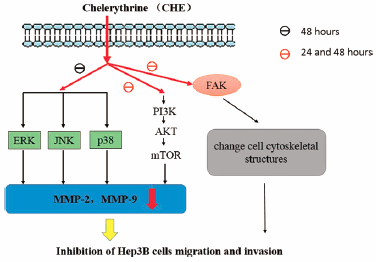 Graphical Abstract Fullsize ImageView full abstractDownload PDF (5363K) Full view HTML
Graphical Abstract Fullsize ImageView full abstractDownload PDF (5363K) Full view HTML -
Chihiro Endo-Tsukude, Ji-ichiro Sasaki, Sho Saeki, Norihiro Iwamoto, M ...2018Volume 41Issue 1 Pages 47-56
Published: January 01, 2018
Released on J-STAGE: January 01, 2018
JOURNAL FREE ACCESS FULL-TEXT HTML
Supplementary materialDeterminants of interindividual variability in erlotinib pharmacokinetics (PK) and adverse events remain to be elucidated. This study with 50 Japanese non-small-cell lung cancer patients treated with oral erlotinib at a standard dose of 150 mg aimed to investigate whether genetic polymorphisms affect erlotinib PK and adverse events. Single nucleotide polymorphisms (SNPs) in genes encoding metabolizing enzymes (CYP1A1, CYP1A2, CYP2D6, CYP3A4, CYP3A5, UGT1A1, UGT2B7, GSTM1, and GSTT1) or efflux transporters (ABCB1, and ABCG2) were analyzed as covariates in a population PK model. The ABCB1 1236C>T (rs1128503) polymorphism, not ABCB1*2 haplotype (1236TT–2677TT–3455TT, rs1128503 TT–rs2032582 TT–rs1045642 TT), was a significant covariate for the apparent clearance (CL/F), with the TT genotype showing a 29.4% decrease in CL/F as compared with the CC and the CT genotypes. A marginally higher incidence of adverse events (mainly skin rash) was observed in the TT genotype group; however, patients with high plasma erlotinib exposure did not always experience skin rash. None of the other SNPs affected PK or adverse events. The ABCB1 genotype is a potential predictor for erlotinib adverse events. Erlotinib might be used with careful monitoring of adverse events in patients with ABCB1 polymorphic variants.
 Graphical Abstract Fullsize ImageView full abstractDownload PDF (661K) Full view HTML
Graphical Abstract Fullsize ImageView full abstractDownload PDF (661K) Full view HTML -
Yanhong Sun, Jun Li, Yi Zhang, Yating Tu, Changzheng Huang, Juan Tao, ...2018Volume 41Issue 1 Pages 57-64
Published: January 01, 2018
Released on J-STAGE: January 01, 2018
JOURNAL FREE ACCESS FULL-TEXT HTMLMelanoma is one of the most aggressive skin cancers with an increasing rate of morbidity. Umbilicaria esculenta is an edible lichen and its main component of extracts—polysaccharide (PUE) has shown significant antitumor effects in a variety of cancer types such as stomach adenocarcinoma. However, whether it has an anti-melanoma effect and the underlying mechanism has not been revealed. In this article, we showed that PUE extracted from Umbilicaria esculenta could inhibit the growth of A875 and A375 melanoma cells but without obvious toxicity to normal vascular endothelial cells. The generation of reactive oxygen species (ROS) in A875 cells was significantly elevated when treated with PUE for 24h. In addition, the expression of caspase-3 and -9 also increased as compared to the controlled group which resulted in the apoptosis of A875 melanoma cells. In the meantime, when pre-treated with N-acetylcysteine (NAC), the ROS scavenger, PUE induced apoptosis and cell death could be reversed via suppression of elevated generation of ROS and ROS-mediated caspase-9 expression. In summary, our study demonstrated that PUE extracts from Umbilicaria esculenta have a potent anti-melanoma effect through the induction of ROS and caspases-3 and -9. It could provide a promising strategy of melanoma therapy with the components from the extracts of natural and edible plants such as lichen Umbilicaria esculenta.
 Graphical Abstract Fullsize ImageView full abstractDownload PDF (5051K) Full view HTML
Graphical Abstract Fullsize ImageView full abstractDownload PDF (5051K) Full view HTML -
Sanung Eom, Yoon Suh Kim, Sung Bae Lee, Shinhwa Noh, Hye Duck Yeom, Hy ...2018Volume 41Issue 1 Pages 65-72
Published: January 01, 2018
Released on J-STAGE: January 01, 2018
JOURNAL FREE ACCESS FULL-TEXT HTMLIn a previous work, we reported the regulatory role of the triterpenoids on 5-hydroxytryptamine (5-HT)3A receptors activity in Xenopus laevis oocytes (Eur. J. Pharmacol., 615, 2009, Lee et al.). In the present report, we studied the modulation of triterpenoids on the activity of the human nicotinic acetylcholine receptor type α3β4. Two-electrode voltage clamp experiments were used to test acetylcholine mediated inward current (IACh). Treatment with triterpenoids (dehydroeburicoic acid, 6α-hydroxypolyporenic acid C and pachymic acid) inhibited IACh in a concentration dependent and reversible manner. The IC50 values for pachymic acid, dehydroeburicoic acid, and 6α-hydroxypolyporenic acid C were 14.9, 37.7, and 20.9 µM, respectively. The inhibitory regulation of IACh by each triterpenoid showed in a non-competitive manner on the activity of α3β4 nicotinic acetylcholine receptors. These results show that triterpenoids (pachymic acid, dehydroeburicoic acid, 6α-hydroxypolyporenic acid C) can be used as agents to modulate the activity of nicotinic acetylcholine receptor type α3β4. Furthermore, molecular docking studies of 6α-hydroxypolyporenic acid C on α3β4 nicotinic acetylcholine receptors in silico showed that this molecule interacted predominantly with residues at cavities in the α3 subunit and β4 subunit. This docking assays indicated four potential binding sites for this ligand in the extracellular region at sensor domain of α3β4 nicotinic acetylcholine receptors. In point mutagenesis of those whose alanine substitution, 6α-hydroxypolyporenic acid C potency decreased on W25A of α3 subunit or N109A of β4 subunit in both mutants. The double mutation of W25A of α3 subunit and N109A of β4 subunit was significantly attenuated inhibitory effects by 6α-hydroxypolyporenic acid C. All taken together, this study revealed that molecular basis of α3β4 nicotinic acetylcholine receptors by triterpenoids and provides a novel potent interaction ligand
 Graphical Abstract Fullsize ImageView full abstractDownload PDF (2673K) Full view HTML
Graphical Abstract Fullsize ImageView full abstractDownload PDF (2673K) Full view HTML -
Ki Wung Chung, Hyeong Oh Jeong, Eun Kyeong Lee, Su Jeong Kim, Pusoon C ...2018Volume 41Issue 1 Pages 73-79
Published: January 01, 2018
Released on J-STAGE: January 01, 2018
JOURNAL FREE ACCESS FULL-TEXT HTMLAbnormal pigmentation owing to excessive melanin synthesis can result in serious problems such as freckles, age-spots, and melanoma. Tyrosinase inhibitors have been an interesting target for the treatment of hyperpigmentation because tyrosinase is the rate-limiting enzyme in melanin synthesis. The screening for strong tyrosinase inhibitors led to the finding of the flavonoid galangin, which showed notable inhibitory effects on mushroom tyrosinase. The IC50 value of galangin (3.55±0.39 µM) was lower than that of kojic acid (48.55±1.79 µM), which was used as a positive control. In silico docking simulation and mechanistic studies demonstrated that galangin interacted with the catalytic sites of tyrosinase and competed with tyrosine. In B16F10 melanoma cells stimulated with α-melanocyte stimulating hormone, galangin inhibited tyrosinase activity as well as melanin production. Although high doses of galangin were cytotoxic, no cytotoxic effects were observed at low doses. In addition, the in vivo efficacy of galangin was evaluated in HRM2 melanin-possessing hairless mice. As measured by the skin-whitening index and melanin staining, repeated UVB exposure increased skin melanin synthesis. Galangin application significantly reduced melanogenesis induced by UVB exposure. Collectively, our data indicates that galangin shows strong tyrosinase inhibition activity, which suggests that it may be an effective skin-whitening agent.
 Graphical Abstract Fullsize ImageView full abstractDownload PDF (2133K) Full view HTML
Graphical Abstract Fullsize ImageView full abstractDownload PDF (2133K) Full view HTML -
Hitoshi Ueno, Ryo Shimizu, Tomofumi Okuno, Hirofumi Ogino, Tomohiro Ar ...2018Volume 41Issue 1 Pages 80-85
Published: January 01, 2018
Released on J-STAGE: January 01, 2018
JOURNAL FREE ACCESS FULL-TEXT HTMLThe protective effects of seleno-L-methionine (SeMet) on oxidative stress in pancreatic islets were investigated with a short-term nicotinamide (NA) and streptozotocin (STZ)-induced diabetic mouse model. ICR mice were intraperitoneally injected twice with 100 mg/kg STZ and 120 mg/kg NA at a 1-d interval and were then orally administered 158 µg Se/kg SeMet with free access to a selenium-deficient diet for 5 weeks. Administration of SeMet significantly improved the levels of glycated hemoglobin (HbA1c), non-fasting and oral glucose tolerance-tested (OGTT) blood glucose, plasma adiponectin and hepatic glycogen that deteriorated by NA/STZ treatment. However, supplementary SeMet did not restore non-fasting plasma insulin levels in NA/STZ treatment group and significantly suppressed OGTT plasma insulin levels in the control group. Although SeMet significantly suppressed 8-hydroxy-2′-deoxyguanosine density in pancreatic islets, SeMet did not restore insulin density. The hepatic and pancreatic mRNA levels of glutathione peroxidase 1 (GPX1) increased by NA/STZ treatment or SeMet administration. These results suggest that although a physiological level of SeMet improves glucose tolerance by exhibiting insulin-mimetic activity in a short-term induced diabetic mouse model under insufficient Se status, the suppression of pancreatic oxidative stress with the induction GPX1 by SeMet supplementation is unlikely to restore insulin storage and secretion.
 Graphical Abstract Fullsize ImageView full abstractDownload PDF (5693K) Full view HTML
Graphical Abstract Fullsize ImageView full abstractDownload PDF (5693K) Full view HTML -
Yuko Fujiwara, Kotaro Hama, Makoto Tsukahara, Ryosuke Izumi-Tsuzuki, T ...2018Volume 41Issue 1 Pages 86-91
Published: January 01, 2018
Released on J-STAGE: January 01, 2018
JOURNAL FREE ACCESS FULL-TEXT HTMLMacrophage foam cells play critical roles in the initiation and development of atherosclerosis by synthesizing and accumulating cholesteryl ester (CE) in lipid droplets. However, in analyzing lipid metabolism in foam cell formation, studies have focused on the sterol group, and little research has been done on the acyl chains. Therefore, we adapted a model system using liposomes containing particular acyl chains and examined the effect of various acyl chains on foam cell formation. Of the phosphatidylserine (PS) liposomes tested containing PS, phosphatidylcholine, and cholesterol, we found that unsaturated (C18:1), but not saturated (C16:0 and C18:0), PS liposomes induced lipid droplet formation, indicating that foam cell formation depends on the nature of the acyl chain of the PS liposomes. Experiments on the uptake and accumulation of cholesterol from liposomes by adding [14C]cholesterol suggested that foam cell formation could be induced only when cholesterol was converted to CE in the case of C18:1 PS liposomes. Both microscopic observations and metabolic analysis suggest that cholesterol incorporated into either C16:0 or C18:0 PS liposomes may stay intact after being taken in by endosomes. The [14C]C18:1 fatty acyl chain in the C18:1 PS liposome was used to synthesize CE and triacylglycerol (TG). Interestingly, the [14C]C16:0 in the C18:1 PS liposome was metabolized to sphingomyelin rather than being incorporated into either CE or TG, which could be because of enzymatic acyl chain selectivity. In conclusion, our results indicate that the acyl chain preference of macrophages could have some impact on their progression to foam cells.
 Graphical Abstract Fullsize ImageView full abstractDownload PDF (3531K) Full view HTML
Graphical Abstract Fullsize ImageView full abstractDownload PDF (3531K) Full view HTML -
Koichi Murano, Hirofumi Ogino, Tomofumi Okuno, Tomohiro Arakawa, Hitos ...2018Volume 41Issue 1 Pages 92-98
Published: January 01, 2018
Released on J-STAGE: January 01, 2018
JOURNAL FREE ACCESS FULL-TEXT HTMLThe role of supplementary selenium on the induction of insulin resistance and oxidative stress in a diabetic mouse model was investigated in NSY mice on a high fat diet (HFD) and administered seleno-L-methionine (SeMet)-containing water for 12 weeks. Significant increases in oral glucose tolerance-tested (OGTT), insulin tolerance-tested, and non-fasting blood glucose levels were observed in mice on a HFD, as well as the significant increases in OGTT and non-fasting plasma insulin levels. Mice on a HFD had decreased plasma adiponectin levels and increased free fatty acid (FFA) levels. Supplementary SeMet significantly augmented OGTT blood glucose levels in mice on a HFD and plasma FFA levels in mice on a normal diet. The mRNA levels of six selenoproteins were measured, and glutathione peroxidase (GPx) 1 and selenoprotein P (SelP) were selected as candidates that may be associated with insulin resistance or oxidative stress in the liver. Hepatic GPx1 expression was elevated in mice on a HFD and SeMet supplementation, and SelP expression increased in mice on a HFD. Histopathological observations in hepatic tissues showed hypertrophy of parenchymal cells and significant expression of 4-hydroxy-2-nonenal in mice on a HFD, indicating lipid accumulation and oxidative stress induction. Hepatic protein tyrosine phosphatase activity also increased by a HFD. These results suggest that hepatic lipid accumulation in NSY mice on a HFD promoted oxidative stress and hepatic SelP expression, and supplementary SeMet induced hepatic GPx1 expression.
 Graphical Abstract Fullsize ImageView full abstractDownload PDF (3757K) Full view HTML
Graphical Abstract Fullsize ImageView full abstractDownload PDF (3757K) Full view HTML -
Yanfen Niu, Yuanfang Zhou, Hua Lin, Li-Hui Gao, Wenyong Xiong, Huajie ...2018Volume 41Issue 1 Pages 99-105
Published: January 01, 2018
Released on J-STAGE: January 01, 2018
Advance online publication: November 01, 2017JOURNAL FREE ACCESS FULL-TEXT HTMLThe mechanism of 3,5,2′,4′-tetrahydroxychalcone on lowing urate level is still unknown. Here we investigated the effects of 3,5,2′,4′-tetrahydroxychalcone on urate levels, xanthine oxidase/xanthine dehydrogenase (XOD/XDH) activities in hypoxanthine-induced hyperuricemic mice, as well as the effects of 3,5,2′,4′-tetrahydroxychalcone on the mRNA expression levels and content of phosphoribosyl pyrophosphate synthetase (PRPS), phosphoribosyl pyrophosphate amidotransferase (PRPPAT) and hypoxanthine-guanine phosphoribosyl transferase (HGPRT). Our results demonstrated that 3,5,2′,4′-tetrahydroxychalcone (1.0, 2.0, and 4.0 mg/kg) reduced the uric acid levels in serum of the hyperuricemic mice in dose- and time-dependent manners. The activities of XOD/XDH in serum and liver were also significantly inhibited by 3,5,2′,4′-tetrahydroxychalcone; In addition, 3,5,2′,4′-tetrahydroxychalcone decreased the mRNA expression of HGPRT in brain and content of PRPS and PRPPAT in liver. These findings demonstrated that 3,5,2′,4′-tetrahydroxychalcone suppresses uric acid production by affecting the critical enzymes, XOD/XDH, PRPS, PRPPAT and HGPRT in purine nucleotide metabolism.
 Graphical Abstract Fullsize ImageView full abstractDownload PDF (985K) Full view HTML
Graphical Abstract Fullsize ImageView full abstractDownload PDF (985K) Full view HTML -
Metabolism of Fentanyl and Acetylfentanyl in Human-Induced Pluripotent Stem Cell-Derived HepatocytesTatsuyuki Kanamori, Yuko Togawa Iwata, Hiroki Segawa, Tadashi Yamamuro ...2018Volume 41Issue 1 Pages 106-114
Published: January 01, 2018
Released on J-STAGE: January 01, 2018
JOURNAL FREE ACCESS FULL-TEXT HTMLTo evaluate the capability of human-induced pluripotent stem cell-derived hepatocytes (h-iPS-HEP) in drug metabolism, the profiles of the metabolites of fentanyl, a powerful synthetic opioid, and acetylfentanyl, an N-acetyl analog of fentanyl, in the cells were determined and analyzed. Commercially available h-iPS-HEP were incubated with fentanyl or acetylfentanyl for 24 or 48 h. After enzymatic hydrolysis, the medium was deproteinized with acetonitrile, then analyzed by LC/MS. Desphenethylated metabolites and some hydroxylated metabolites, including 4′-hydroxy-fentanyl and β-hydroxy-fentanyl, were detected as metabolites of fentanyl and acetylfentanyl in the medium. The main metabolite of fentanyl with h-iPS-HEP was the desphenethylated metabolite, which was in agreement with in vivo results. These results suggest that h-iPS-HEP may be useful as a tool for investigating drug metabolism.
 Graphical Abstract Fullsize ImageView full abstractDownload PDF (1070K) Full view HTML
Graphical Abstract Fullsize ImageView full abstractDownload PDF (1070K) Full view HTML -
Mohammad Shahriar Khan, Souleymane Coulibaly, Maho Abe, Nami Furukawa, ...2018Volume 41Issue 1 Pages 115-122
Published: January 01, 2018
Released on J-STAGE: January 01, 2018
JOURNAL FREE ACCESS FULL-TEXT HTMLTo determine the levels of endotoxin, which is a major component of outer membrane of Gram-negative bacteria, and protein in the atmosphere in Sasebo, Japan, we measured these biological materials in fine (aerodynamic diameter ≤2.5 µm) and coarse (≥2.5 µm) particles collected for 81 weeks (September 2014 to May 2016). The monthly concentrations (i.e., the mean value of weekly concentrations for each month) of endotoxin were higher in coarse particles than in fine particles. Fluctuations in monthly endotoxin concentrations were large in both fine (0.0005–0.0208 EU/m3) and coarse (0.0032–0.1164 EU/m3) particles. Furthermore, the endotoxin concentrations in coarse particles were highest in October 2014 and 2015 as well as September 2014 (0.0407–0.1164 EU/m3). However, the monthly protein concentrations were higher in fine particles than in coarse particles. Compared to the endotoxin concentrations, the fluctuations in the monthly protein concentrations were smaller in both coarse and fine particles. To our knowledge, this study is the first to report long-term atmospheric concentrations of endotoxin and protein in Japan. Since the endotoxin concentrations in coarse particles were positively associated with the concentrations of Na+ and Cl−, it suggests the involvement of Gram-negative bacteria from seawater to the endotoxin levels in the atmosphere. For fine particles, the protein concentrations were positively associated with the concentrations of particles, NO3− and SO42−. These results suggest that combustion of organic materials, such as biomass burning, may be a contributor to atmospheric protein during this study period.
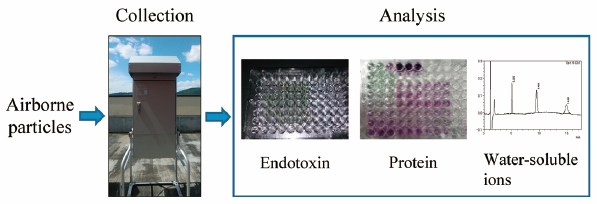 Graphical Abstract Fullsize ImageView full abstractDownload PDF (455K) Full view HTML
Graphical Abstract Fullsize ImageView full abstractDownload PDF (455K) Full view HTML -
Izumi Morita, Hiroyuki Oyama, Yui Kanda, Mayumi Yasuo, Aya Ito, Masahi ...2018Volume 41Issue 1 Pages 123-131
Published: January 01, 2018
Released on J-STAGE: January 01, 2018
JOURNAL FREE ACCESS FULL-TEXT HTMLKetamine (KT) is a chiral anesthetic agent, (R)- and (S)-enantiomers of which differ in their pharmacological properties. KT has become one of the most commonly used illicit drugs in the world, thus, rapid and feasible on-site testing is required to crack down on the illicit use. Although immunochemical approach with specific antibodies is promising for this purpose, in practice anti-KT antibodies are difficult to obtain. We here disclose generation of monoclonal antibodies against KT. Mice were immunized with either (a) commercially-available or (b) in-house-prepared KT-albumin conjugates. Splenocytes from these mouse groups (a and b) were separately fused with P3/NS1/1-Ag4-1 myeloma cells. After standard screening and cloning, we established 5 hybridoma clones: 2 were derived from group-a mice [generating Ab-KT(a)#2 and #37] and 3 were from group-b mice [generating Ab-KT(b)#9, #13, and #45]. These antibodies exhibited practical performance in competitive enzyme-linked immunosorbent assay systems. When (±)-KT·hydrochloride (HCl) was used as the competitor, dose–response curves showed midpoint values of 30 and 70 ng/assay (a-series antibodies) and 2.0–3.0 ng/assay (b-series antibodies). Remarkably, the a-series antibodies were specific for (S)-KT·HCl, while the b-series antibodies were specific for (R)-KT·HCl. Ab-KT(a)#2 (Ka, 7.5×107 M−1) and Ab-KT(b)#45 (Ka, 7.7×108 M−1) exhibited the highest enantioselectivity for each group, and cross-reactivity with the (R)- and (S)-antipodes was 1.3 and 1.7%, respectively. The hybridomas established here are also valuable as a source of genetic information for the anti-KT antibodies, which is required for progressing to next-generation technologies using genetically engineered antibodies.
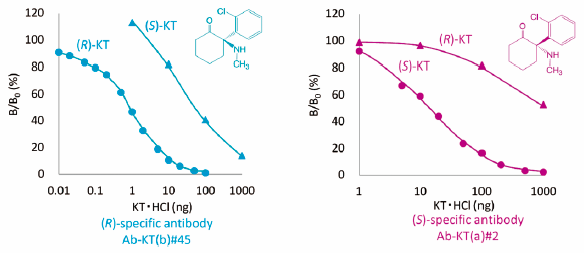 Graphical Abstract Fullsize ImageView full abstractDownload PDF (1537K) Full view HTML
Graphical Abstract Fullsize ImageView full abstractDownload PDF (1537K) Full view HTML
-
Momochika Kumagai, Akio Watanabe, Izumi Yoshida, Takashi Mishima, Mune ...2018Volume 41Issue 1 Pages 132-137
Published: January 01, 2018
Released on J-STAGE: January 01, 2018
JOURNAL FREE ACCESS FULL-TEXT HTML
Supplementary materialAnti-inflammatory activity of aculeatin and toddaculin, which are coumarins with a similar structure isolated from Toddalia asiatica (L.) LAM., was evaluated using lipopolysaccharide (LPS)-stimulated RAW264 mouse macrophage cells. Both aculeatin and toddaculin significantly inhibited mRNA expression of inflammatory mediators and nitric oxide production. Furthermore, Toddaculin suppressed LPS-induced phosphorylation of p38 and extracellular signal-regulated kinase (ERK)1/2 and inhibited LPS-induced activation of nuclear factor-kappaB (NF-κB). However, aculeatin did not exhibit such effects, suggesting that aculeatin and toddaculin suppress LPS-induced inflammation of RAW264 cells via different mechanisms. The cellular uptake of these compounds was also evaluated. Toddaculin was detected in RAW264 cells after 4 and 24 h. However, aculeatin levels were not observed in RAW264 cells at all incubation intervals. These results indicate that de-epoxidation of a prenyl group can increase hydrophobicity of molecule and is thought to accelerate cellular uptake and/or interactions with the phospholipid bilayers of cell membranes.
 Graphical Abstract Fullsize ImageView full abstractDownload PDF (810K) Full view HTML
Graphical Abstract Fullsize ImageView full abstractDownload PDF (810K) Full view HTML -
Soichiro Nakahara, Mitsuyuki Matsumoto, Hiroyuki Ito, Katsunori Tajind ...2018Volume 41Issue 1 Pages 138-141
Published: January 01, 2018
Released on J-STAGE: January 01, 2018
JOURNAL FREE ACCESS FULL-TEXT HTML
Supplementary materialAppropriate axonal pathfinding is a necessary step for the function of neuronal circuits. The mossy fibers (MFs) in the hippocampus of CaMKIIα heterozygous knockout (CaMKIIα-hKO) psychiatric model mice project onto not only the stratum lucidum but also the stratum oriens region in the CA3, which is a projection pattern distinct from that in normal mice. Thus, we examined the electrophysiological properties of the MF–CA3 connection in this mutant mouse on field recordings and found a lower synaptic connection. This study suggested that the phenotype of abnormal MF pathfindings could induce aberrant neuronal functions, which may link to cognition and memory.
 Graphical Abstract Fullsize ImageView full abstractDownload PDF (1019K) Full view HTML
Graphical Abstract Fullsize ImageView full abstractDownload PDF (1019K) Full view HTML -
Aya Okamoto, Takao Morinaga, Noritaka Yamaguchi, Naoto Yamaguchi2018Volume 41Issue 1 Pages 142-146
Published: January 01, 2018
Released on J-STAGE: January 01, 2018
JOURNAL FREE ACCESS FULL-TEXT HTMLSrc-family tyrosine kinases, classified as cytosolic enzymes, have crucial roles in regulating cell proliferation, differentiation, migration and cell-shape changes. Newly synthesized Lyn, a member of Src-family kinases, is biosynthetically accumulated at the cytoplasmic face of caveolin-containing Golgi membranes via posttranslational lipid modifications and then transported to the plasma membrane. However, the precise intra-Golgi localization of Lyn remains elusive. By means of a 19°C block-release technique and short-term brefeldin A treatment, we show here that the distribution of Lyn is not monotonously spread within the Golgi but selectively intensified in two distinct membrane compartments: giantin- and caveolin-positive membranes and trans-Golgi network protein (TGN)46-positive but caveolin-negative membranes. Furthermore, Lyn exits the Golgi from the caveolin-positive cis-Golgi cisternae or the caveolin-negative trans-Golgi network. These results suggest that Lyn moves apart from caveolin, a secretory protein, within the Golgi during Lyn’s trafficking to the plasma membrane.
 Graphical Abstract Fullsize ImageView full abstractDownload PDF (12668K) Full view HTML
Graphical Abstract Fullsize ImageView full abstractDownload PDF (12668K) Full view HTML -
Kohta Kurohane, Ayako Kimura, Rie Terasawa, Kamiyu Kobayashi, Wakana S ...2018Volume 41Issue 1 Pages 147-150
Published: January 01, 2018
Released on J-STAGE: January 01, 2018
Advance online publication: October 27, 2017JOURNAL FREE ACCESS FULL-TEXT HTMLAlternative plasticizers have become more popular due to health concerns about phthalate esters. We demonstrated that phthalate esters enhanced skin sensitization to fluorescein isothiocyanate (FITC) in mouse contact hypersensitivity models. Alternative plasticizers have not been well studied as to their effect on the immune system. We previously found that diisopropyl adipate (DIPA), an aliphatic dicarboxylic acid ester, enhanced skin sensitization to FITC. Sebacate esters are also widely used as alternative plasticizers. Here we tested diisopropyl sebacate (DIPS), which has the same alcohol with an aliphatic dicarboxylic acid of longer chain, using BALB/c mice. The results showed that DIPS facilitated skin sensitization to FITC and increased FITC-presenting dendritic cell trafficking from the skin to draining lymph nodes. Furthermore, DIPS activated transient receptor potential ankyrin 1 (TRPA1). The latter feature has been commonly observed for phthalate esters and DIPA, which have adjuvant effects. In summary, the adjuvant effect of a sebacate ester was demonstrated in a mouse model.
 Graphical Abstract Fullsize ImageView full abstractDownload PDF (595K) Full view HTML
Graphical Abstract Fullsize ImageView full abstractDownload PDF (595K) Full view HTML
-
2018Volume 41Issue 1 Pages 151
Published: January 01, 2018
Released on J-STAGE: January 01, 2018
JOURNAL FREE ACCESS FULL-TEXT HTMLDownload PDF (99K) Full view HTML
- |<
- <
- 1
- >
- >|